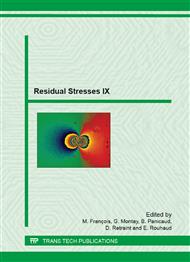p.112
p.118
p.124
p.128
p.135
p.141
p.147
p.155
p.162
Microscopic Stress and Strain Evolved in a Twinning-Induced Plasticity Fe-Mn-C Steel
Abstract:
White X-ray diffraction with micro-beam synchrotron radiation was used to analyze microscopic stress evolved in coarse grains of a twinning-induced plasticity Fe-Mn-C steel under tensile loading. In addition, electron backscatter diffraction (EBSD) was used to determine the crystal orientation of grains in the polycrystalline Fe-Mn-C steel. Based on these orientation data, the stress and strain distribution in the microstructure of the steel under tensile loading was estimated using FEM simulation where the elastic anisotropy or the crystal orientation dependence of the elasticity was taken into account. The FEM simulation showed that the strain distribution in the microstructure depends on the crystal orientation of each grain. The stress analysis by the white X-ray diffraction indicated that the direction of the maximum principal stresses at measured points in the steel under tensile loading are mostly oriented toward the tensile direction. This is qualitatively consistent with the results of by the FEM simulation, although absolute values of the principal stresses may contain the effect of heterogeneous plastic deformation on the stress distribution.
Info:
Periodical:
Pages:
135-140
Citation:
Online since:
August 2014
Permissions:
Share:
Citation:


